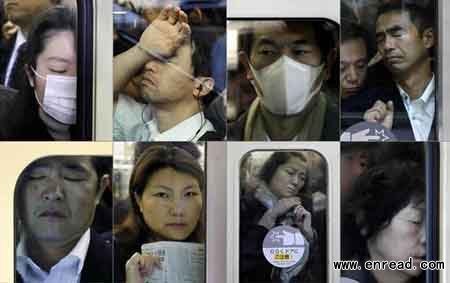| ||||||||||||||||||||||||||||||||||||||||||||||||||||||||||||||||||||||||||||||||||||||||||||||||||||||||||||||||||||||||
|
If you think your commute1 is a living hell, then spare a thought for these subway passengers in Tokyo. Packed like sardines2 into sweaty, claustrophobic carriages, these passengers can barely breathe let alone move about freely.
如果你觉得自己的上班路上太拥挤,不妨想想东京地铁上的乘客。车厢内挤得像沙丁鱼罐头一样,汗臭和幽闭的车厢让人几乎无法呼吸,更不用说自如走动了。
 Packed like sardines into sweaty, claustrophobic carriages, these passengers can barely breathe let alone move about freely. The photographs are the work of Michael Wolf, a German-born artist who has been capturing the cramped3 conditions of the Japanese capital's transport network for 15 years.
Tokyo is world famous for its urban density4 and so the public transport nightmare is hardly surprising.
Standing5 on the platform as the doors snap shut, Wolf has been able to capture a whole range of expressions from his unwilling6 and trapped subjects.
Some stare disconcertingly(使人窘迫地) at the lens, others close their eyes to try and escape the brutal7 overcrowding, while others have their faces contorted against the steamy glass windows.
Wolf first experienced the Japanese subway network when reporting on the aftermath of the sarin nerve gas attack which killed 16 people and injured 6,000 in 1995. His collection of images quickly grew into a portfolio8 first exhibited in 2008.
'I shot six frames of faces of early morning commuters in subway windows which turned out to be very powerful images,' said Wolf.
'I spent 20 days [Monday to Friday] every morning from 7.30 until 8.45 at the same subway station shooting portraits of people on their way to work.'
'The images create a sense of discomfort10 as his victims attempt to squirm out of view or simply close their eyes, wishing the photographer to go away,' reads the description on Wolf's website.
Eleven million commuters use Tokyo's transport network every morning, with suburban11 and subway trains reliably packed to the brim from first light to late morning.
It is a sign that Tokyo's tsukin jigoku [commuting hell] has grown steadily12 out of hand that the railway companies have employed white-gloved oshiya (pushers) to shove passengers into carriages since 1955.
Regular commuters have become deft13 at performing what is known as the Tokyo pirouette(脚尖旋转), which allows them to slide into the carriage and then stand without having to make eye contact with those who have moved aside.
Scuffles between frustrated14 commuters have become more and more common, while notorious chikan [subway molesters] take advantage of the overcrowding to fondle fellow passengers.
Passengers are well trained in using whatever they have on them - bags, briefcases15 and umbrellas, for example - to fight for space. Police have reported a massive rise in 'commuter9 incidents' - injuries and assaults.
点击  收听单词发音 收听单词发音
|
||||||||||||||||||||||||||||||||||||||||||||||||||||||||||||||||||||||||||||||||||||||||||||||||||||||||||||||||||||||||
上一篇:英国百万职员因工作压力未休完年假 下一篇:法国封锁“末日避难山” |
||||||||||||||||||||||||||||||||||||||||||||||||||||||||||||||||||||||||||||||||||||||||||||||||||||||||||||||||||||||||
- 发表评论
-
- 最新评论 进入详细评论页>>



